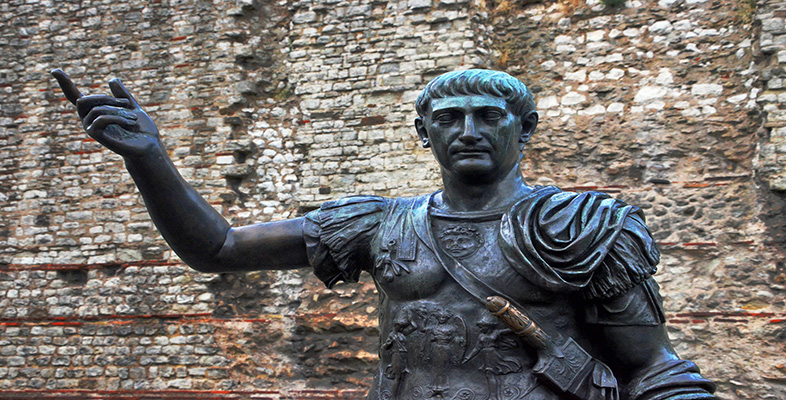2.4 Image
In the city of Rome the emperor glorified his relationship with the provinces. Here you will consider how the emperor was exalted in the provinces. It was impossible for the emperor to be seen personally by all his subjects and so methods were employed to publicise his face and name – to overcome geographic distance by making the emperor familiar to his people. Standardised images of the emperor – on statues, busts and coins – were widely copied and placed in prominent public locations.
Exercise 3
To explore these and some additional methods you should now watch ‘The emperor in the provinces’, below. This video sequence examines how the face and name of the emperor were promoted in the provinces.
You may find it useful to refer to the map showing the provinces of the empire (Map 1 from Experiencing Rome, below) and the statue of Augustus (Plates 1 and 2).
Please click to view the map [Tip: hold Ctrl and click a link to open it in a new tab. (Hide tip)] . (PDF, 1 page, 0.4 MB)
Please click to view Plate 1 Marble statue of Augustus, found in the Via Labicana, Rome. The head is covered, suggesting Augustus' role as pontifex maximus. After 12 BC, height 207 cm. Museo Nazionale, Rome. (Photo: Alinari). (PDF, 1 page, 1.7 MB)
Please click to view Plate 2 Detail of Plate 1. (Photo: Alinari). (PDF, 1 page, 2.3 MB)
As you watch note the major ways in which the image of the emperor was presented in the provinces.
Emperor and empire (part 1; 9 minutes)
Transcript: Emperor and empire - part 1
Emperor and empire (part 2; 6.5 minutes)
Transcript: Emperor and empire - part 2
Emperor and empire (part 3; 6 minutes)
Transcript: Emperor and empire - part 3
Discussion
The video sequence focuses on both the visual and verbal means that were used to promote the emperor in the provinces. Busts, statues and coin images recorded the likeness of the emperor and could associate him with certain attributes. So the emperor might be represented as a priest or a soldier, while on coins his image might be associated with military victories and conquests or idealised virtues. (For further discussion of this, see Experiencing Rome Essay Two, pp. 42–4.) The name of the emperor was recorded through inscriptions which could also list his official titles and authority. Inscriptions might accompany statues and portraits but were often associated with buildings and structures. These might be funded by the emperor, who was thus recorded as a benefactor providing a gift to the local community; or the buildings might be dedicated to the emperor by local communities. An important avenue for promoting the name and image of the emperor was the imperial cult. Through buildings and rituals the relationship between emperor and provincial was placed in a religious context.
The image of the emperor was promoted in the provinces through multiple methods. Additional areas not explored in the video include further elements of the emperor's role as a benefactor. For example the emperor might fund local shows or gladiatorial contests, or he could elevate the status of a community or reward elements of the population with Roman citizenship. Such actions might be commemorated by inscriptions and those who gained citizenship under a given emperor normally adopted elements of the imperial nomenclature as their own. But above all such actions indebted the populace to the emperor and promoted loyalty to his name and image.
Promoting the name of the emperor entailed benefits to both sides. It was to the emperor's advantage to gain popularity and support, but it could also benefit the local community to gain imperial favour. It is often difficult to reconstruct the specific circumstances behind certain actions such as the erection of statues. Did the emperor dictate that these should be set up? Or was it a spontaneous gesture from the provincial community? Often the reality probably lay somewhere between the polarity of an enforced action and a voluntary one. Both sides knew the benefits to be gained and the power that was associated with the face and name of the emperor.
